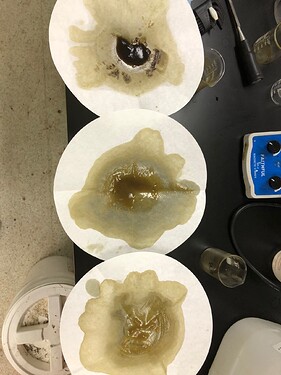You can absolutely add water for winterizing any alcohol solution more effectively. You’ll run into issues with cannabinoid loss as you add water, once you get below a certain % the solution doesn’t hold the cannabinoids and your oil will fall out.
Methanol has a higher affinity for cannabinoids than ethanol, so adding some water to make the solution more polar, will allow you greater range in added water % and dewaxing potential.
Ethanol will work too, just not as effectively.
I think temperature will still knock out its own selection of junk. It all depends on what your end product needs to look like.
1 Like
So, just on the initial test, I have some insight. The solubility point is 70% ethanol and below, there’s a dark layer at the bottom (the crude) and the top is the solution with water with is an orange color. So my 65% and 70% ones are a non-starter. The way I prepped this was taking 10g samples and pouring their respective solvents over them; its very viscous and I don’t have a sand bath to keep the crude warm. However, the other ones are a dark color, denoting solubilization of more non-polar colorant molecules. After only a few minutes, I can see what looks like fat/wax crystals crashing in the 75%, 80% and 85% batches.
The material I’m extracting is c buds from trimming, the guy doesn’t want pre-rolls so he’s having it extracted, if that helps.
1 Like
Ok, good to know on methanol, I really can’t use it because it would just be a nightmare for safety and compliance (I’m in Vermont and they are very strict about everything). So perhaps ethanol water isn’t as good compared to methanol. However, when comparing to ethanol at -40, it seems like a good move since when cooling ethanol like that, it would cause a loss of affinity as well, so it would be a lateral move on performance, but the cost end equipment requirements are a no brainer.
How are you measuring affinity by the way? I usually go by feel more than anything else, but I’m not really sure how that would be quantified
The polarity to Winterize ethanol (or simply exclude lipids from extraction) at room temperature is achieved at 95% ethanol (190 proof). This precipitates branched lipids like the epicuticular wax, and any of the heaviest triglycerides (hemp oil). To remove 99% of these lipids, it only needs cooled to normal freezer temperatures (perhaps -10°F). However, if you also want to precipitate free fatty acids (FFAs), you can use degumming enzyme, citric, phosphoric, or oxalic acid dissolved at room temperature before filtering out any other lipids or cooling… then chill and filter in small batches to keep the flocculants cold, avoiding redissolving them while filtering.
Note: Phosphoric & oxalic acids have been known to add funky odor or flavor to distilled products.
The best way to treat the resin after cooled citric acid degumming filtration is a louched (watered down alcohol) LLE into alkane, and subsequent washes of the alkane with pure water. This has the additional benefit of eliminating any sugars, proteins and alkaloids from the ethanol extract, which is especially imperative if ethanol extraction was performed above -20°C, on heavily damaged cells, and/or overly moist biomass.
2 Likes
Interesting, that may actually make a lot of sense. Here’s a brief story on why this may be important. I was and still am a bit of a novice (but I’m a synthetic chemist so there’s a balance), and I was just extracting with ethanol, winterizing, dewax through celite; t5; AC, then distilling (I’m getting an organic processing license so no alkanes allowed). Every time I ran a distillation (5L regular short path), the bottom would be filled with char and tar like you wouldn’t believe. A solid chunk of carbon that wouldn’t dissolve in refluxing alconox even after multiple dewaxing runs, took several days to clean. We then did a brine wash of the crude (just the crude, no alkanes) and this made a lot of things easier for us. Less grainy crude, no charring in the still.
I had always figured I wasn’t doing a good enough job dewaxing, but the wash made 1000% difference, so maybe I was taking dewaxing as seriously.
Also @Photon_noir, as I’ve been conversing with people today, the experiment has been progressing, and in the photo I, the 75-85% ones have noticeable flocculant only after a few minutes and have been gaining some over the last few hours. Curious if doing a 85% “winterization” would be a way to go, and just raise the solvent ratio to prevent losses of an overloaded solvent.
I also have zero experience extracting with hydrocarbons, but I’m guessing dewaxing is a much more prevalent issue due to the polarity of butane/propane.
Make sure it is actually lipid flocculant and NOT precipitation of cannabinoids! The solubility of cannabinoids drops VERY quickly as the water concentration increases beyond the natural azeotropic ratio in ethanol!
Results are in. Just upon visual inspection, there is a noticeable difference in what washed over. On top is the 75% EtOH, stepping up to 80% and then 90% on the bottom. @photonoir, you are correct, the top obviously has cannabinoids left in it just by the color, while towards the bottom, it has the same color as our normal 190 proof -40 dewaxing. It’s a bit darker than I’d like, so I’ll up the solvent ratio or more likely give it another wash with its respective solvent.
1 Like
I’ve seen that black coloration happen to a razor blade that had some wax left on it. Turned the surface if the metal real dark red, almost black.
It’s probably corrosion from the metal.
Um, this wasn’t in contact with metal at any point, that’s just the color of the crude
I was directing that comment at the OP.

